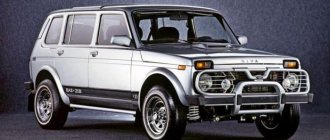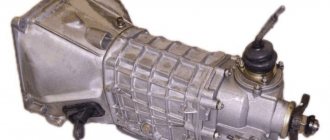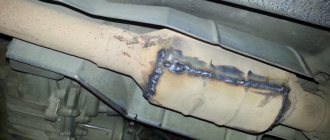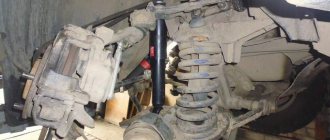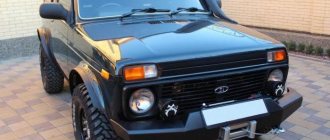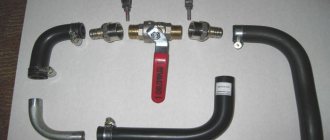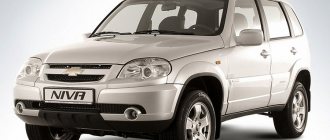Floor panel (front, middle, rear) Sill and floor sill box connectors Inner side panel Lower side panel Rear front fender reinforcement Front fender mudguard Rear fender extension Body side Front door panel (outer and inner) Rear door panel (outer and inner) Panel rear doors (external and internal) Front fender Rear fender
Chevrolet Niva 1.7 (80 hp) 5MT
| Manufacturer | GM - AVTOVAZ |
| Year of issue | 2013 |
| In operation "Behind the wheel" | since May 2013 |
| Mileage | 125,060 km |
| Maintenance costs | RUB 650,259 |
| Of which for gasoline (AI-95, average consumption 11 l/100 km) | RUR 506,428 |
| Cost of 1 km* | 5.20 rub. |
* Excluding costs for compulsory motor liability insurance and motor insurance policies.
Operation and repair reports, as well as tests involving the Chevrolet Niva:
Body reinforcement
Despite the high preparation of the car, in our operating conditions it still wouldn’t hurt to increase the rigidity of the Chevrolet Niva body with your own hands.
This does not mean that the manufacturer uses obviously weak and unmodified Chevrolet Niva body iron, it’s just that this unit can withstand the heaviest loads, which we will try to reduce by using various struts and amplifiers.
To do this, you don’t need to invent anything or reinvent the wheel, everything is already on sale. I will present to you a few of the many options offered:
Body reinforcements
- when driving straight on roads with poor surfaces and at high speeds, it significantly increases vehicle stability;
- improves steering response when cornering, allowing you to take them at higher speeds;
- reduces steering angles when taking turns with the same radii, which reduces the complexity of driving a car;
- more predictable car behavior;
- with better stability and controllability, the suspension remains smooth.
Stretch marks
- reduces vehicle roll;
- the steering wheel return speed increases;
- excellent directional stability at cruising speed (100…110 km/h);
- the feedback to the steering wheel decreases when driving at low speeds (10...20 km/h) on bumpy roads;
Stabilizer
By connecting opposite wheels using a torsion bar, the stabilizer redistributes the loads that arise when the car rolls sideways. It lifts the body on the tilted side and lowers it on the high side, that is, the following happens:
- alignment of the body relative to the road surface in sharp turns;
- roll reduction;
- improved tire grip when cornering.
Stretcher
- protection of the power unit from impacts from below;
- increasing the rigidity of suspension and body mounting points;
- improved controllability (anti-dive effect, stabilization) and suspension kinematics;
- increase in vehicle base (15 millimeters) and castor angle (1.5 degrees).
Rear suspension A-arm
This universal element, due to a large-diameter welded stabilizer, simultaneously increases both the lateral and longitudinal rigidity of the rear suspension, which practically eliminates the lateral roll of the car during dynamic cornering.
Powertrain supports
- the amplitude of the engine is reduced, which affects the clarity of gear engagement;
- eliminating the influence of amplitude fluctuations of the center of gravity of the internal combustion engine on controllability due to dynamic optimization of its suspension.
It is especially important to strengthen the body when buying a used car, because who knows what the car has seen in its lifetime, fortunately this car has quite a few opportunities to see “something a lot”.
But my advice to you is that before strengthening the Chevrolet Niva body, you need to check the control points of the Chevrolet Niva body with your own hands.
As you can see, with the help of the components offered to your attention, strengthening the body hardware on a Chevrolet Nivun is nothing complicated. The only question is, why?
If you use the car only for country trips and maximum family outings, then of course there is no need. But if your lot is in the open spaces of off-road and deep taiga, then only with the use of the devices described above will you discover the full potential of the car.
| The table indicates whether the body of the Chevrolet Niva, produced from 2009 to 2014, is galvanized, and the quality of processing. |
| Treatment | Type | Method | Body condition | |
| 2009 | Full | Galvanic galvanization (double-sided) | zinc layer 9 - 15 microns | Galvanization result: Good The car is already 11 years old. Considering the age and quality of zinc treatment of this car (under normal operating conditions), the corrosion of the body has just begun. It is difficult to notice if the car has not been subjected to shocks and scratches. |
| 2010 | Full | Galvanic galvanization (double-sided) | immersion in a zinc electrolyte under the influence of current, a layer of zinc 9 - 15 microns includes a share of aluminum parts | Galvanization result: Good The machine is already 10 years old. Considering the age and quality of zinc treatment of this machine (under normal operating conditions), the first corrosion will begin in 1 year. |
| 2011 | Full | Galvanic galvanization (double-sided) | immersion in a zinc electrolyte under the influence of current, a layer of zinc 9 - 15 microns includes a share of aluminum parts | Galvanization result: Good The machine is already 9 years old. Considering the age and quality of zinc treatment of this machine (under normal operating conditions), the first corrosion will begin in 2 years. |
| 2012 | Full | Galvanic galvanization (double-sided) | immersion in a zinc electrolyte under the influence of current, a layer of zinc 9 - 15 microns includes a share of aluminum parts | Galvanization result: Good The machine is already 8 years old. Considering the age and quality of zinc treatment of this machine (under normal operating conditions), the first corrosion will begin after 3 years. |
| 2013 | Full | Galvanic galvanization (double-sided) | immersion in a zinc electrolyte under the influence of current, a layer of zinc 9 - 15 microns includes a share of aluminum parts | Galvanization result: Good The machine is already 7 years old. Considering the age and quality of zinc treatment of this machine (under normal operating conditions), the first corrosion will begin after 4 years. |
| 2014 | Full | Galvanic galvanization (double-sided) | immersion in a zinc electrolyte under the influence of current, a layer of zinc 9 - 15 microns includes a share of aluminum parts | Galvanization result: Good The machine is already 6 years old. Considering the age and quality of zinc treatment of this machine (under normal operating conditions), the first corrosion will begin after 5 years. |
When a galvanized body is damaged, corrosion destroys the zinc and not the steel
.
Types of processing
Over the years, the processing process itself has changed.
A younger car will always be better galvanized! Types of galvanizing
The presence of zinc particles in the soil covering the body does not affect its protection and is used in advertising materials.
. Tests
The results of tests of cars that came off the production line with the same damage (a cross) on the lower part of the front right door.
Tests were carried out in the laboratory. Conditions in a chamber with hot salt fog for 40 days correspond to 5 years of normal operation. A car with hot galvanization
(layer thickness 12-15 microns)
A car with galvanic galvanization
(layer thickness 5-10 microns)
A car with cold galvanization
(layer thickness 10 microns)
A car with zinc metal A car without galvanization Important to know
- Over the years, manufacturers have improved galvanizing technology their cars.
A younger car will always be better galvanized! — A coating with a thickness of 2 to 10 microns
(micrometers) provides excellent protection against the occurrence and spread of corrosion damage.
— The rate of destruction of the active zinc layer at the site of body damage ranges from 1 to 6 microns per year
.
Zinc degrades more actively at elevated temperatures. — If “full” is not added
, it means that only elements exposed to impacts were processed.
— Pay more attention to the presence of a manufacturer’s warranty on the body rather than loud phrases about galvanizing from advertising. Additionally
Until the General Motors concern withdrew budget Chevrolet models from our market, they were bought very well. Not a bad price, a spacious interior for its class, time-tested Opel engines, and you could choose one of three body types - hatchback, sedan and station wagon. And to this day, used Chevrolet Cruzes are still in demand, largely due to the body’s resistance to corrosion. Whether Cruz’s body is galvanized or not, we’ll find out together today.
Video about the assembly of a Chevrolet Cruze at the factory:
This chip has been here for a long time, but no saffron milk caps have appeared. The body is galvanized well.
According to most data from the manufacturer and various enterprises where the Chevrolet Cruze was produced, the body is still partially galvanized.
The paint on the other wing has peeled off, there are no saffron milk caps.
Nevertheless, there are examples that have never seen zinc and, as a rule, these are cars assembled in St. Petersburg
. Regardless of the presence of zinc on the surface, the paint layer on all Chevrolet Cruzes is quite thin and weak. Therefore, the most banal household injury is enough to cause a chip to form on the paintwork, and thin metal contributes to the formation of small dents.
On years
And yet there is some official information about the galvanization of Chevrolet Cruze of different years of production.
- For example, cars manufactured in 2001–2002
had only partial galvanization. This means that only the most corroded elements of the body and tail were subjected to treatment. The zinc coating layer did not exceed 9 microns, but was double-sided. - Since 2003,
all Chevrolet Cruzes began to be galvanized using full processing technology with a layer of zinc up to 15 microns thick. - And since 2009,
the restyled Cruises have had some aluminum elements in the body, while the thickness of the zinc layer and the galvanizing technique have not changed. Consequently, almost all Chevrolet Cruze cars must have at least some galvanized body elements.
The chips on the hood have turned rusty. This is a St. Petersburg-built Cruise.
Questions (29)
- Most useful
- The newest
Hello. Please tell me what kind of horror stories are circulating on the Internet (I am attaching a link to the video) about clicks in the transmission when changing gears and backlash in manual transmissions and main gearboxes on new cars? Thank you. (Anton)
Sergey Mishin
, editor of the magazine “Behind the Wheel” (automotive information department):
— Anton, good afternoon! We watched the video you sent the link to:
I don't quite understand what the question is. Personally, I didn’t see any “horror stories”. I can't agree that this is all about "new cars" in the plural. In my opinion, this is a story about an isolated incident. And it’s not a fact that this is a factory defect. Perhaps this story clearly speaks only of the incompetence of the dealer. It is not clear why the transfer case was changed.
There are clicks in the front axle gearbox and in one of the CV joints of the driveshaft. I can assume that the main “culprit” of transmission knocks is the front axle gearbox, and play in its hypoid engagement could provoke intense wear of the CV joint.
The play in the hypoid gearing could have been incorrectly adjusted during assembly (manufacturing defect), which is highly unlikely. By the way, if desired, this engagement can be adjusted. However, I do not rule out the possibility that the play appeared as a result of improper operation of the car - as a result of driving on hard roads with the center lock engaged, which ensures a rigid connection between the drive axles.
The fact is that when cornering and even when driving in a straight line on an uneven road, all four wheels of the car travel different paths. And if the wheels do not have the ability to slip (as, for example, on snow or ice), then intensive wear of the transmission elements occurs. First of all, hypoid gear parts in cross-wheel gearboxes, especially in the front one.
In this case, I would analyze the oil in the front gearbox and inspect the hypoid gears. If there are metal shavings in the oil, and there are signs of wear on the gears, it means that the backlash appeared during operation due to incorrect driving conditions.
Try a little experiment. Make a couple of circles on dry asphalt with a minimum radius (the center lock must be turned off). Now, leaving the front wheels turned out, turn off the engine, put the transmission in neutral and roll the car manually along the knurled circle. Feel that this can be done quite easily. Now turn on the center lock and try to do the same. Make sure you can't drive the car even half a circle. This will not allow power to circulate through the transmission; it will simply stop the car. It will stop as if it were in gear.
If you use the engine, you will hear the whistling of tires sliding on the asphalt, or the grinding of hypoid pairs (front and rear axles) in the transmission. This mode causes intense wear of the gears of this very hypoid gearing. So, the more you use the engaged center lock on asphalt, especially dry, the more you destroy the car.
And here is an example of fairly rapid wear of other transmission parts during operation, typical for all-wheel drive vehicles with a rigidly connected front axle (UAZ and the like). When operating on asphalt in rear-wheel drive mode, many disconnect the front wheels from the axle shafts using wheel couplings. This makes it possible to eliminate the rotation of the axle shafts, front gearbox and driveshaft from the wheels of a rolling vehicle and thus slightly reduce fuel consumption. However, on road irregularities the front axle moves up and down due to the suspension, which forces the front driveshaft to change its length - a splined connection helps it in this. But since the front cardan and the axle gearbox do not rotate, the wear of the splines does not occur evenly, but only in one (vertical) plane, and quite intensively, especially if there is insufficient lubrication in this connection. If you turn on the front axle at some point and connect the axle shafts to the wheels, you will feel knocking sounds in the unevenly worn spline joint of the front driveshaft. And an illiterate driver is to blame for the appearance of these knocks.
Chevrolet Niva body
The Chevrolet Niva off-road body confirms its purpose with permanent all-wheel drive of a mechanical type transmission, the presence of a reduction gearbox and forced differential locking.
Of course, these transmission characteristics are of decisive importance in overcoming various obstacles, but at this point we will not be completely frank if we do not separately note the geometric cross-country ability that the Chevrolet Niva body fully possesses:
- shortened overhangs allowing you to overcome ramps and exits with elevation angles of 35...37 degrees;
- high two hundred millimeter ground clearance coupled with a 24-degree ramp angle allows you to immediately take on the steepest off-road conditions.
In general, the Chevrolet Niva body very successfully complements the capabilities of mechanical all-wheel drive and provides the driver with ample opportunities for fast and reliable off-road driving.
The body of the Chevrolet Niva is made of load-bearing, welded, all-metal with five doors.
Chevrolet Niva body iron (its component elements) are connected to each other using resistance, spot welding, and in hidden cavities and hard-to-reach places by semi-automatic welding (in an inert gas environment), which has significantly increased the rigidity coefficient of the body.
Not the least role in the high performance of this parameter was played by the fact that the rear door glass with side clearances, as well as the windshield, are glued into the body opening, which also makes them part of the power circuit.
Welding seams and joints of element panels are sealed with mastic.
The side doors have roll-down windows and are attached to hinges located at the front. The rear door is hinged, with hinges on the left side.
Safety glass, curved:
- wind - 3-layer, polished;
- door glass – tempered, polished (rear glass with heating element).
In addition to the choice of vehicle configuration, the manufacturer offers a choice of Chevrolet Niva, the body colors of which also differ in a variety of shades:
History of Chevrolet Niva.
The first sample of the VAZ 2123 Niva was shown at the Moscow Motor Show in 1998. The future Shniva differed from the VAZ 21213 in wheelbase, body shape, transmission and more expensive interior trim. In essence, it was a new car, maximally unified with the VAZ 21213 mastered in production.
Unfortunately, she inherited not only advantages, but also disadvantages.
AvtoVAZ did not have enough money to develop the new model, and then the plant went to sell the Niva brand to General Motors Corporation. GM made more than 1,700 changes to the car's design and organized production under its own brand in 2002. So the VAZ 2123 became the Chevrolet Niva.
Until 2009, the car was produced practically unchanged; in 2009, a minor restyling was carried out during which the car received several trim levels, plastic lining on the body panels and a new transmission.
In our article we will look at both pre-restyling and post-restyling cars and evaluate the work of the plant in fine-tuning the model.
Weaknesses of the pre-restyling Shnivy 2002-2009
Engine.
The engine is reliable, and drives while in near death, spare parts for it are common and are available on any collective farm, there are only three problems with it:
— it is very weak for a field. 79 horsepower accelerates the car to 100 km/h in 19 seconds; overtaking and speeds above 110 km/h are difficult for the car.
- as a consequence of the first two points - high fuel consumption. In winter, in the city cycle with warm-ups, it can easily be 16-18 liters, on the highway 8-9, the mixed cycle is a utopia.
Clutch.
The clutch, with its original release bearing (in a plastic cage), really doesn’t like rocking. The cage melts and the clutch disappears! The treatment is to replace the release bearing with a VAZ 2101 bearing. Doing it yourself is not very expensive, but replacing the release bearing is not a trivial task - you will have to disassemble half the car
Transmission.
Transmission.
With timely maintenance there are no problems with it.
Transfer case.
The unit is quite capricious; while downshifts and neutral are engaged relatively easily, the center lock engages with enormous effort at the slightest wear. The transfer case usually does not howl, but due to the backlash of the gears, it contributes to the sounds of transmission knocks. When buying a car, be sure to check the center lock. On 2 of my machines it turned on with problems.
Cardan shafts.
Before the 2009 restyling, the car rattled its cardans... After 2009, this problem was corrected, but shocks in the transmission remained due to the design of the transfer case and gearboxes with drives
Body.
Rotting begins from the wheel arches, bottoms of doors and sills. The quality of the coloring is not high and the chips bloom quickly.
The body also desperately needs to improve sound insulation; if up to 100 km/h the car is relatively comfortable, then after this milestone you have to strain your voice.
The main drawback of the body is the very small trunk (but this is not surprising given the size of the Niva’s wheelbase). This can be treated by installing a roof rack, but this will worsen the aerodynamics and add noise.
Weaknesses of the restyled Chevrolet Niva 2009 - present.
Restyling 2009 Made the Niva a little better, but there was a fly in the ointment.
Engine.
With the transition to Euro 3 and higher, a catalytic exhaust gas converter was introduced. In our conditions, it fails at 60,000-80,000 km and is replaced by our optimizers with a flame arrester from cars with Euro-2 engines (at the same time, the environmental class is reduced, but money and fuel are saved.
There are quite a lot of negative reviews about the 16-valve Opel engine offered as an option, so we won’t consider it.
Also, after restyling in 2009, air conditioning became available in 2 basic configurations (before restyling it was an option). In general, a car with air conditioning is more comfortable, but due to a weak engine, fuel consumption increases greatly and at idle, with the power steering and air conditioning operating simultaneously, the engine speed drops very significantly.
Transmission.
In general, the shocks from the transmission went away, but the difficulty in engaging the center lock remained, and the release bearing was never cured.
By body
The plastic linings of the wings and doors became hotbeds of corrosion. The linings are glued to the doors and over time dust accumulates under them, which gets wet and the whole thing actively rusts, although the attractive appearance lasts for a long time.
A common drawback throughout the entire production period is the quality of spare parts in retail sales, but this is not the fault of the designers and the manufacturer.
Equipment and configurations since 2009.
conclusions
Most Cruises are galvanized during assembly!
Based on the operating experience of Chevrolet Cruzes of different years of production, we can say that the bodies are completely galvanized, except for the roof, using the galvanic galvanizing method with a layer of 10–15 microns.
It is important to know that the zinc layer can deteriorate at the site of damage at a rate of 1 to 5 microns per 12 months
and the higher the ambient temperature, the faster the destruction occurs. Protect the body from damage and coat the zinc with paint and varnish in a timely manner, good roads to everyone!
For the first six to seven years, the Chevrolet Niva body resists corrosion well, but then red dots gradually begin to appear at all joints and corners of the car. The gas tank cap, hood, fender and door edges suffer the most. Deep chips in the paint rust quickly enough; of course, we are not talking about any galvanizing.
The paintwork is of average quality; chips and scratches do not appear as quickly as on other cars. This, of course, is additionally influenced by more than 20 cm of ground clearance and a plastic body kit. However, quite often the paint can begin to swell on its own, especially on the arches and hood. The trim between the trunk door and the rear bumper often peels off.
How to fight rust on thresholds.
A heavy spare wheel sooner or later causes the rear door to sag and it begins to close poorly. The bumper fastenings weaken over time and quite noticeable gaps form between them and the body. There is often play in the driver's door and door handles. When lowered frequently, the glass gradually becomes covered with scratches and eventually warps and jams.
The weak point of the lower part of the car is the side members. They become covered with rust and are often deformed from jacking. The engine protection can rub against the curved spar while driving; the creaking is especially audible during turns. In older cars, the fuel pipes in the area of the right wheel often rot.
The trunk is quite modest, only 320 liters; folding the seats allows you to increase its volume to 650 liters, but for transporting long items the depth of the resulting opening will be too small. The upholstery is very practical and easy to clean, but the additional niches are just a disaster; there’s really nowhere to put the driver’s belongings. Some configurations include a branded shovel hanging on the fifth door on the other side of the spare tire.
The interior of the Niva Chevrolet is a hodgepodge of VAZ models from the late 90s, most of the parts are from model 2115. The plastic is hard, echoing, but wear-resistant. The only thing that will stick is the new steering wheel, which appeared in 2009. Drivers complain about the small number of containers for small items and the terrible rattling of the glove compartment lid.
Sound insulation is very poor. Both the engine and tires are clearly audible, and at high speed they are complemented by the whistling of the wind from the side mirrors. At certain engine speeds, approximately between 2500 and 3000, the gearshift lever begins to vibrate. And in the range from 80 to 100 km/h the transfer case howls madly; usually the owners try to drive either faster or slower.
Due to a clogged drain behind the expansion tank, water may enter the cabin. The heater radiator also often leaks, and does so directly on the front passenger’s feet. Replacing it on a model equipped with air conditioning will require complete disassembly of the panel. The control cables for the dampers of the ventilation and heating system stretch and burst. The stove makes a lot of noise, but heats very well.
Oversized drivers have loose seats. The front panel may become deformed when exposed to direct sunlight, especially the glove compartment lid (it simply stops closing). Cold air can blow through torn boots of the gearbox and transfer case levers, and water can seep through the steering shaft seal and antenna mount.
In 2009, the car was seriously modernized. The update was led by the Italian design studio Bertone, so the restyling affected the appearance of the car and the interior decoration. The radiator grille has changed, new lensed headlights have appeared, and the lights have acquired a different pattern, the bumpers have changed, and the rear one received a convenient rubber pad that makes it easier to load large cargo.
The interior now has a different steering wheel with three spokes and a more comfortable gear knob, an open box and two cup holders between the seats, different seats and a better quality headliner. Finally we made normal lamp shades and an eyeglass case. The door seals are thicker, and optional roof rails are available, as are body-colored door handles and mirrors. We revised the sound insulation and the design of the wheel rims.
Chevy Niva is one of the few cars on the Russian market that does not have an airbag in the basic version. However, starting with the GL configuration, both the driver and front passenger have it, and they also have belt pretensioners. The only active safety system is ABS.
The car was crash tested twice, both times in 2011. Representatives of the GM-AvtoVAZ company tested the export version in the maximum configuration and it did well, with 12.5 points out of 16 possible. But AutoReview journalists tested the basic model for our market and the result was predictably terrible - only 1.6 points out of 16.
AutoReview test failure
In terms of electrical under the hood, the main problems are mainly related to the generator, or more precisely to the wiring around it. First it burns, then the contacts and finally the diode bridge. In 2014, the unit was modernized. Another weak point is the starter. It has a short lifespan, since it is located in close proximity to the exhaust manifold and operates in unfavorable temperature conditions. When parked for a long time, the battery often runs out.
In the cabin, the fuel level gauge is usually the first to go, then the coolant temperature, then the windshield wiper and turn signal relays. But all this most often happens closer to the hundred thousand mileage. Heated mirrors, seats and rear windows, as well as power windows, often fail. Moreover, they do this spontaneously, and may even stop working on a new machine.
The original central locking key fob is extremely short-lived. When the lights are turned on, the ignition sometimes turns on, despite the fact that the key is not even inserted into the lock. The light from the headlights is quite good, especially after restyling, but due to poor contacts, sometimes the lamp sockets burn and the plastic of the reflectors melts.
The suspension is energy-intensive, but on regular asphalt this leads to excessive body sway, which is most felt when cornering. The rear passengers are especially uncomfortable; they are even thrown onto speed bumps. The car fully opens up on rough terrain, long suspension travel and permanent all-wheel drive allow you to drive where modern crossovers with complex electronic filling fail.
Up to about 50,000 km, there is usually no knocking or rattling, but then intervention is most often required. The first to go are the ball joints in the front and the torque rod silent blocks in the rear. The rubber-metal joints of the upper right arm burn out due to the constant thermal effect of the exhaust gas exhaust system. By 100,000 km, many parts may require replacement, including shock absorbers.
There will be a separate conversation about wheel bearings. They require adjustment and tightening approximately every 30 thousand kilometers, then their service life will be about 80 thousand. Regular outings with trips through mud and water reduce the service life of wheel bearings, as well as brake drums, by about half.
The pedals are quite far from each other, so you can drive in heavy boots. Thanks to an effective vacuum booster, the car brakes well, the pedal is soft throughout the entire stroke. Front brake pads last approximately 30-40 thousand, discs 60-70 thousand km. The rear drums can easily travel 120 thousand kilometers, although the pads in them will have to be changed twice during this time. It is better to replace brake hoses preventively at 100,000 km; they can crack at the most unexpected moment.
Good afternoon, dear readers. The topic of today's article is the weak points of the Chevrolet Niva car. The article was written based on the experience of owning cars produced in 2006. and 2012 onwards
